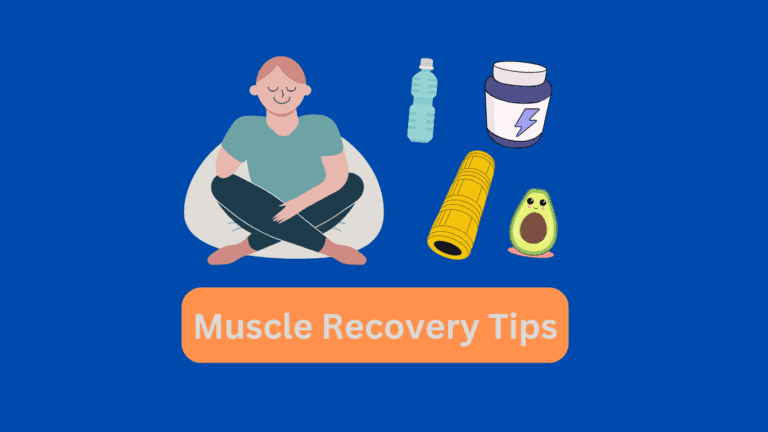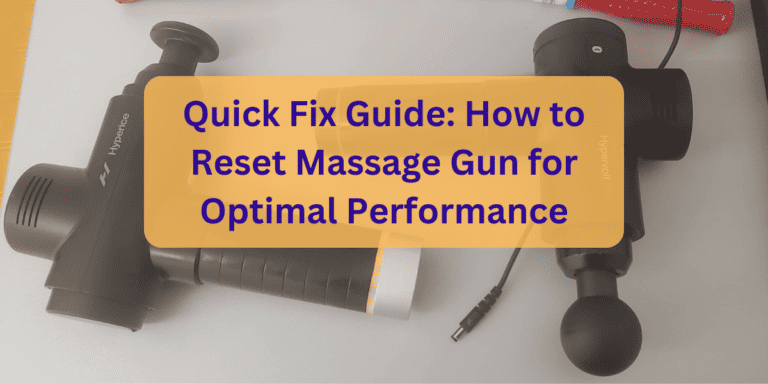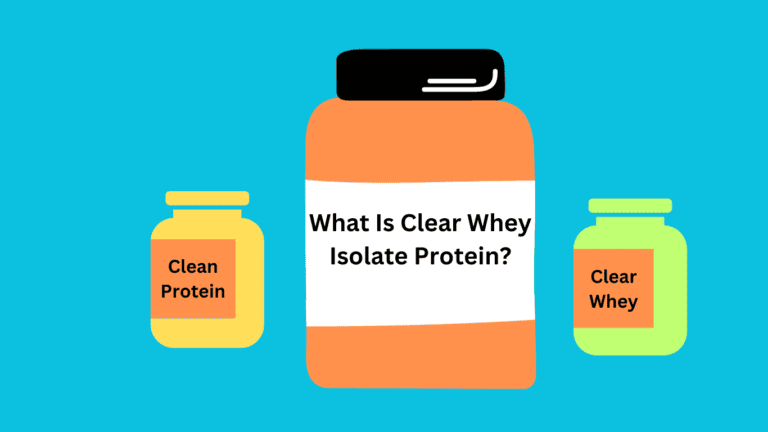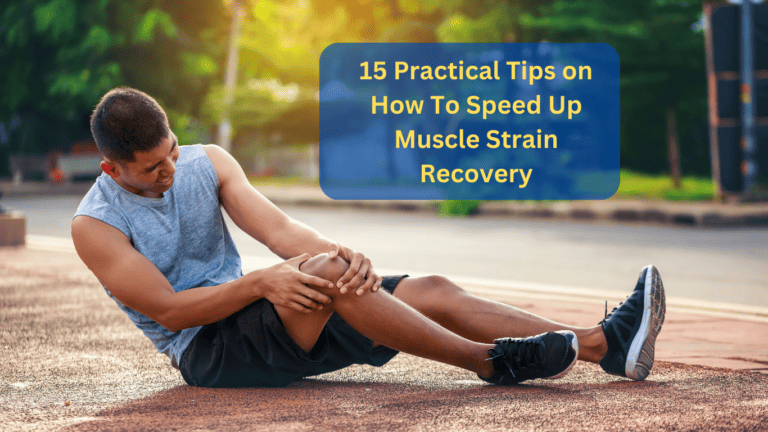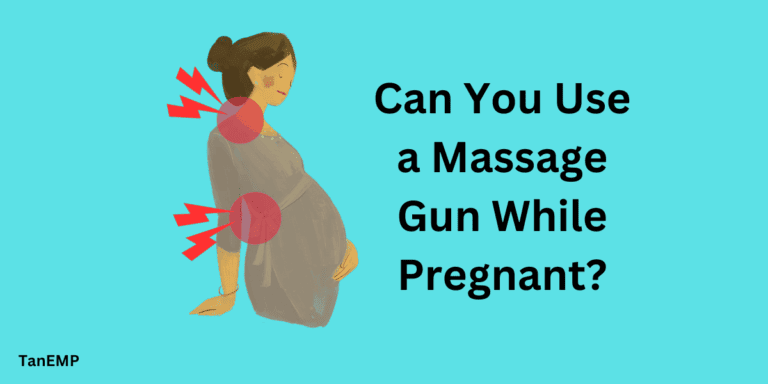How to Use a Massage Gun Safely: Insights from a Chiropractor
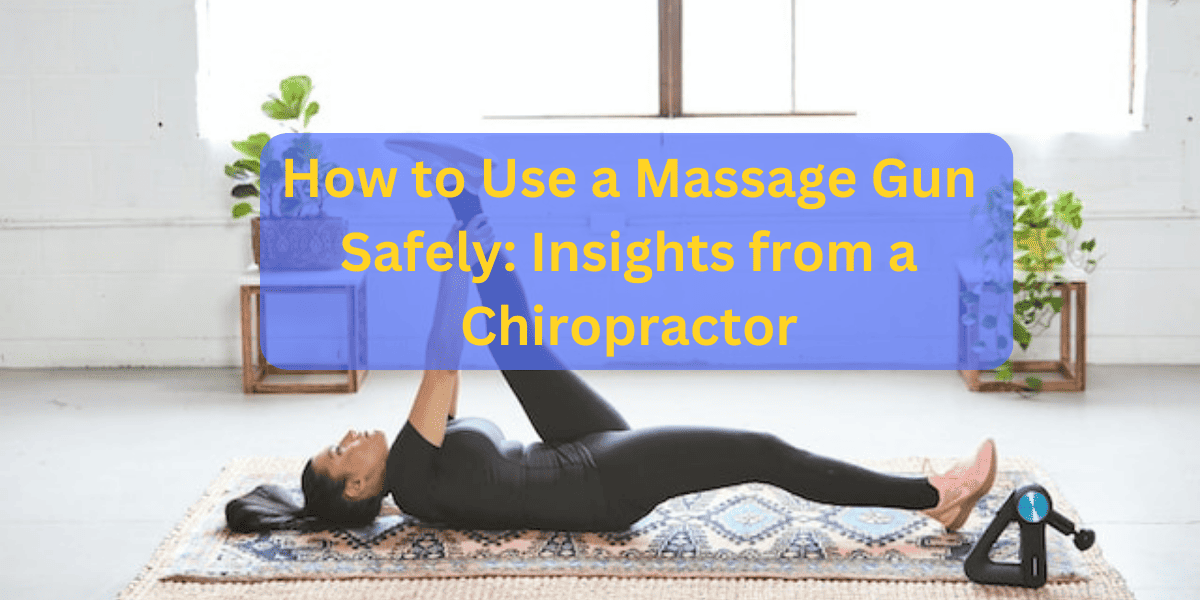
Using a massage gun is easy, but do you know how to use it safely without injury?
I always recommend my patients use their massage guns regularly for maximum benefits.
However, not many people know how to use a massage gun the right way.
One of my patients came in stating she couldn’t raise her arm after using a massage gun.
I asked her what happened. She said she aggressively used the massage gun on her shoulder for 20 minutes to treat her tender muscles.
Based on a study, inappropriate use of massage guns may cause damage to your muscles. This may be the case for my patient who applies excessive pressure during her percussive therapy, and leads to muscle injury.
In this blog post, you will learn my insights as a chiropractor on how a massage gun should be used properly so you won’t end up like my patient.
The Steps to become an expert in using a massage gun:
- What is percussive therapy and how do massage guns work
- Choose the right massage gun
- Proper technique for using a massage gun before, during, and after workouts
- Recommended duration and frequency for massage gun use
- Safety precautions to take when using a massage gun
By learning how to properly use a massage gun, you can improve delayed onset muscle soreness and reduce recovery time.
Let’s dive in!
What Is A Massage Gun?
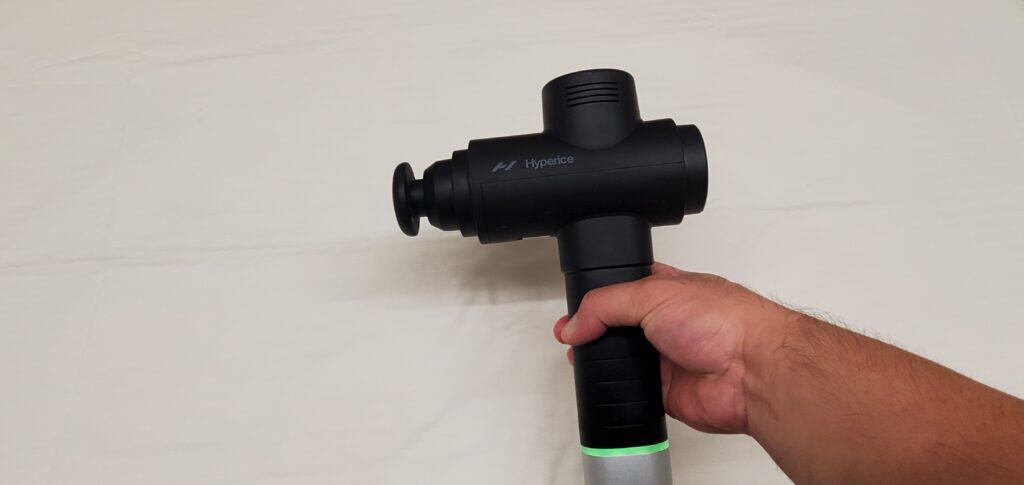
If you’re not familiar with a massage gun, it is a powerful massage tool that looks like a power drill.
It was invented by Dr. Jason Wersland (a chiropractor) in 2007 after his motorcycle accident.
The purpose of this powerful massage tool is to help you break down muscle adhesion that develops from intense workouts, trauma, immobility from prolonged sitting, or muscle strain.
Throughout the years, many versions of massage guns like the theragun have appeared in our market. But which one is better, and how much should you spend on the massage gun?
For more details on how to choose the right massage gun for you, see our roundup of the best budget massage guns.
Disclaimer: This content is based on my personal experience as a beginner runner and chiropractor. It is for informational purposes only and should not be taken as medical advice. If you have pain while running or any medical concerns, please consult with your healthcare provider before starting any new exercise program.
What Is Percussive Therapy?
The massage guns use percussive therapy, also known as percussion massage.
This type of massage involves applying rapid, short strokes of pressure into the muscle tissue through the massage gun attachment.
To effectively treat muscle knots or sore muscles, the attachment heads must penetrate at least 12-16mm into the muscle.
Benefits of Percussive Therapy
- Helps release muscle tension
- Break up muscle knots
- Increase mobility
- Improve delayed onset muscle soreness.
- Improves blood flow to the affected areas
- Enhancing the delivery of oxygen nutrients to the muscle fibers
- Flushing out metabolic waste products that build up after exercise
If you purchase through our partner links, we get paid for the referral at no additional cost to you!
What Is Vibration Therapy?
Vibration therapy is a milder version of percussive therapy.
The amplitude of vibration therapy is less than persussive therapy around 8mm to 10 mm into the muscle fibers.
If we compare vibration therapy to therapeutic massage, think of therapeutic massage as deep tissue and Swedish massage as gentler.
The vibrations help relax the muscles, stimulate blood flow, and reduce pain signals. If you’re looking for a deep-tissue massage to get rid of knots, then vibration therapy may not be as effective as percussive therapy.
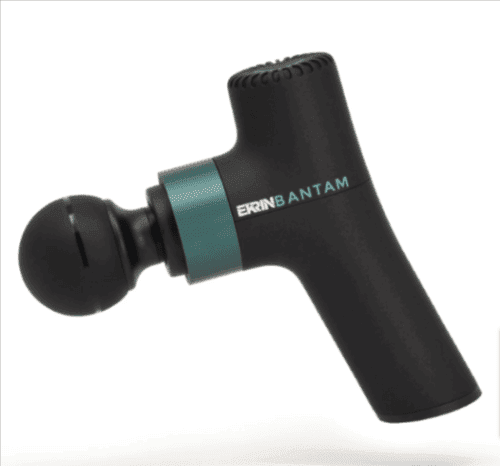
Product Highlight
- 3 speeds (2000-3200 RPM)
- 6-hour battery life
- 4 Attachments
- Ultra lightweight at 1.1 lbs
- 35 lb stall force
Why Do You Need A Massage Gun?
With the rapid rise in the popularity of massage guns, you may be wondering if massage guns are useful or just a scam.
According to scientific research and first-hand accounts from athletes and therapists, massage guns can be a valuable recovery tool in decreasing muscle pain and improving performance.
Here are some of the key reasons you may want to use a massage gun
- Reduce muscle soreness and fatigue – Percussive therapy can help relieve muscle tightness and tension to accelerate recovery.
- Improve circulation – The massage technique enhances blood flow to supply muscles with oxygen and nutrients.
- Relax muscles – The vibrations help muscles unwind after workouts or injury.
- Break up scar tissue – Helps treat and prevent adhesions and restricted mobility.
- Increase flexibility – Loosens muscle stiffness to expand the range of motion.
Related Post: Quick Fix Guide: Quick Fix Guide: How to Reset Massage Gun for Optimal Performance
Why Is It Important to Use a Massage Gun Properly?
As stated above, massage gun has many benefits. But you need to use it properly to get these benefits.
With over 10 years of experience in deep-tissue massage and ART therapy, excessive pressure will do more harm than good.
Whenever you get a massage or use your massage gun, you need to be gentle with your muscles.
No pain, no gain may work in training, but not when you’re dealing with your muscles.
Any form of massage, including massage guns, may cause microtears in muscle fibers with prolonged use.
The microtear here may be beneficial for muscle recovery. But if you go past the threshold, you may cause damage to your muscle fibers.
So next time you use your massage gun, keep in mind that be gentle with your speed and pressure to ensure you use your massage gun correctly.
How To Use Massage Gun on Each Body Parts
How to use massage gun on Calves
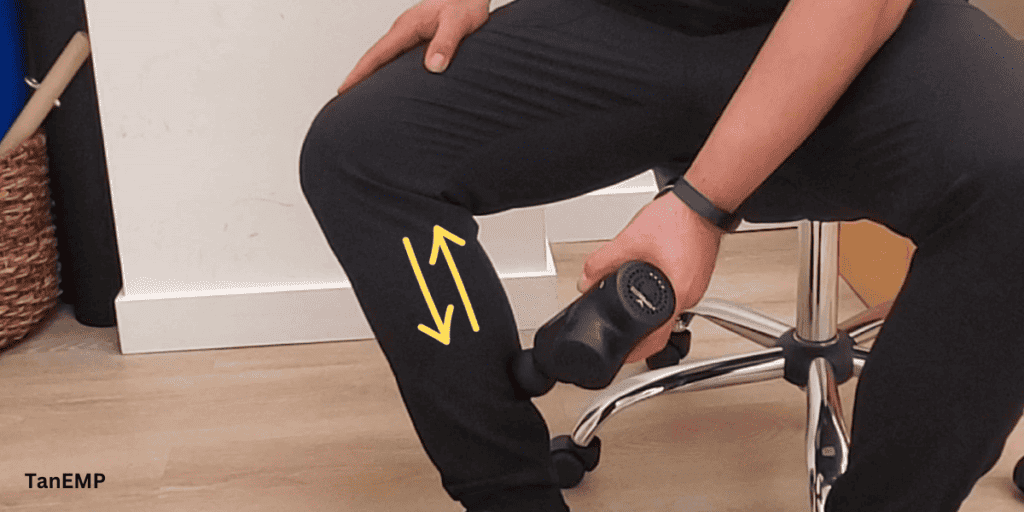
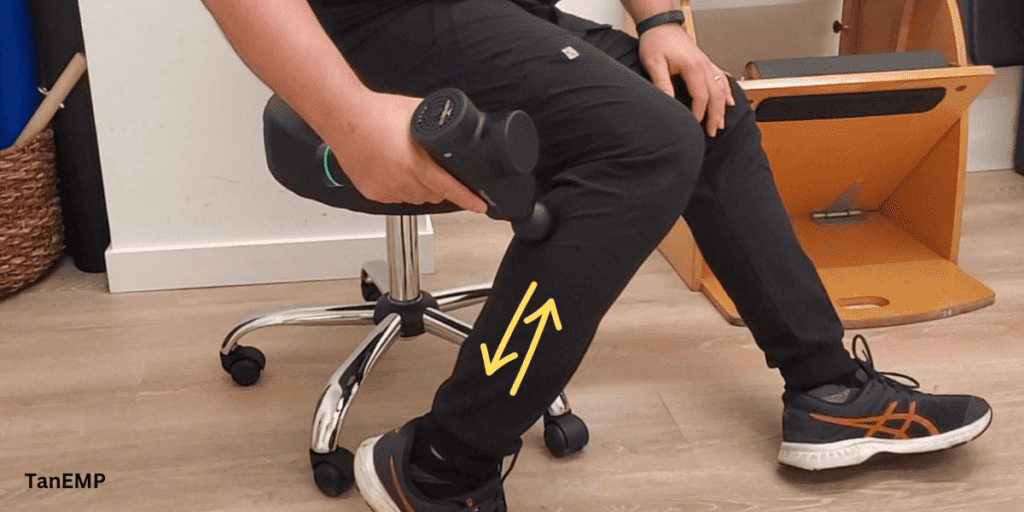
Caution: If you’re pregnant, avoid using a massage gun on your calves. Consult with your healthcare provider before using a massage gun.
How to use massage gun on the adductor
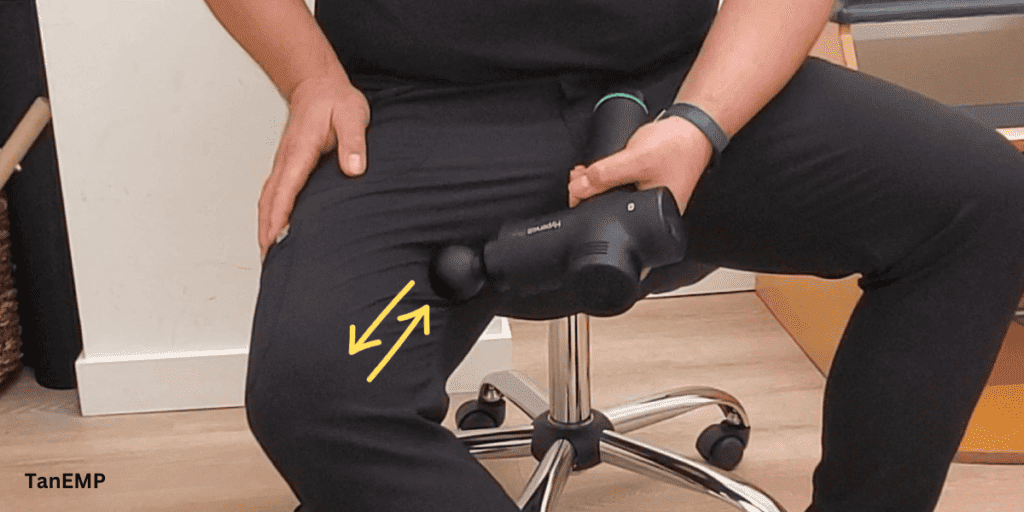
How to use massage gun on gluteus
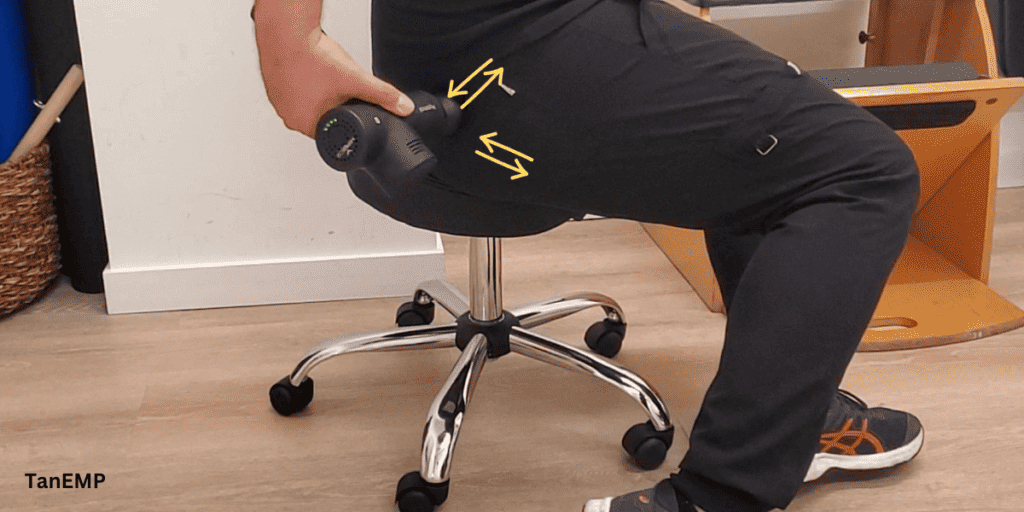
How to use a massage gun on Biceps
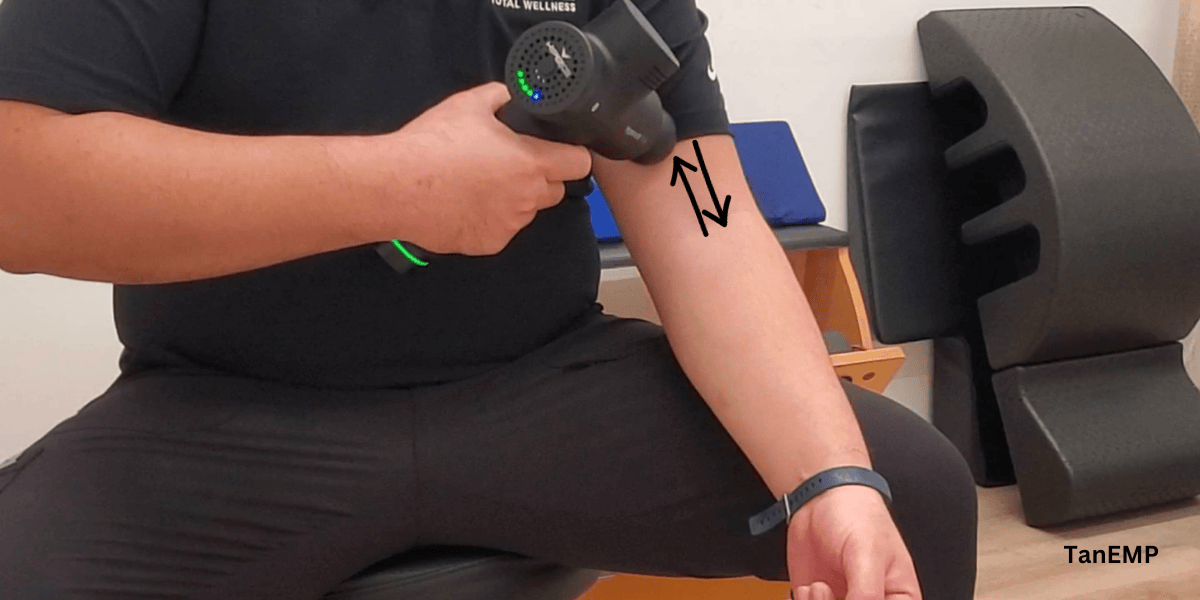
How to use a massage gun on Forearm
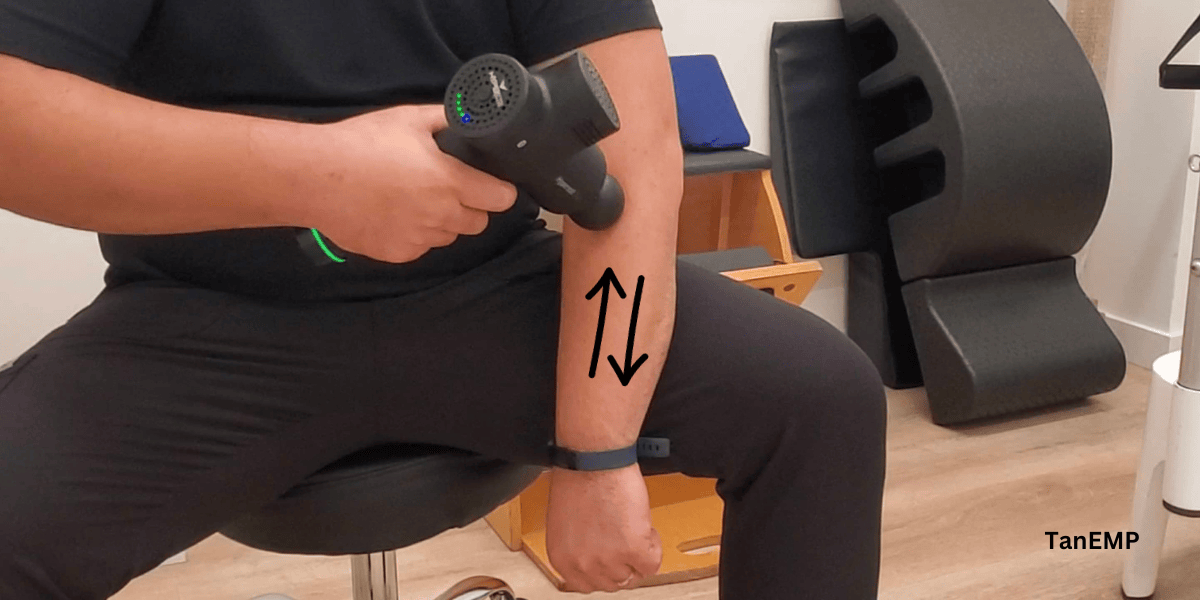
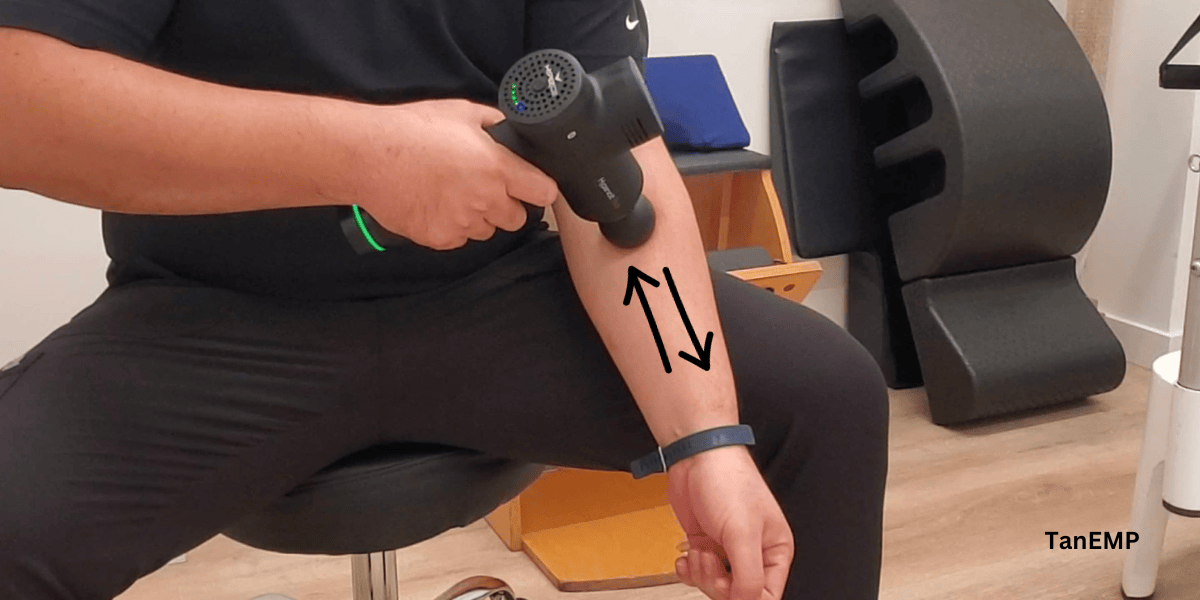
How to use a massage Gun Before Workouts
Using a massage gun before working out can also have benefits for performance and injury prevention. Warming up your muscles before intense activity helps increase their pliability, primes them for movement, and boosts activation.
Spend 30 seconds on the large muscle groups involved in your workout. You don’t need to target a single muscle group; focus on the entire muscle group instead.
Runner or lower body workout:
- 30 seconds on each Gluteus
- 30 seconds on each hamstring
- 30 seconds on each calve
- 30 seconds on each quad
Upper body workout:
- 30 seconds on each Pec (be careful not to apply excessive pressure)
- 30 seconds on each deltoid
- 30 seconds on each biceps
- 30 seconds on each triceps
- 30 seconds on each forearm
- 30 seconds on each trap
Spending 5-10 minutes with the massage gun targeting the major muscle groups you plan to work can help maximize your training performance.
When using a massage gun, apply light pressure and a low setting to avoid bruising or delayed muscle performance.
How to use a massage Gun After Workouts
One of the most popular ways to use a massage gun is after an intense workout.
Your muscles are likely fatigued, tight, and sore following intense exercise. Using a massage gun after your training sessions can help accelerate recovery and get you ready for your next gym day.
Instead of spending 30 seconds on the muscle before workout usage, you will spend 1-2 minutes on each muscle. This allows the percussive therapy to increase blood flow and break off adhesion fibers.
Using a massage gun for 5-10 minutes daily can be beneficial for your health. However, it’s important to use it in moderation, as excessive usage can cause harm.
How to use a massage Gun For Tight Muscles
Whether you use a massage gun on tight or sore muscles doesn’t make a huge difference. To get the maximum benefits, it’s recommended to try different massage heads.
For instance, you can use a flat head attachment for larger muscle groups and a round head attachment for more focused areas. I like to switch between the two during my treatment.
How Often Should You Use a Massage Gun?
It is important to be consistent when using a massage gun, as many of my patients tend to forget that they have one or only use it when they experience pain.
To minimize delays caused by sore muscles and maximize the benefits of your workout, it is recommended to use the massage gun consistently 3-4 times a week, with each session lasting no more than 10 minutes.
Although you can use it longer, it is ideal to keep it under 10 minutes, especially if you have a busy schedule.
How Long Can You Use a Massage Gun?
I always tell my patients to use their massage guns as often as possible.
Keeping each usage under 10 minutes is more than enough for the percussive therapy to be effective. You can use it for 30 minutes, but 30 minutes is spread out between different body parts.
Using your massage gun for 5 minutes daily is more effective than using it once a week for 30 minutes.
When Not To Use A Massage Gun?
Massage gun is low invasive therapy, but there are some times you don’t use a massage gun.
Below are some conditions you should avoid massage gun therapy:
- Acute pain: Acute pain is less than 7 days of injury. You should use ice and rest, and avoid percussive therapy because it may worsen the pain.
- Bone Fracture: NO massage gun on fractured bone.
- Diabetes: It is not recommended for diabetic individuals to use percussive therapy. The risk of diminished sensation in parts of the body may cause more damage to the muscle, nerve, and blood vessels during percussive therapy.
- Blood clog disorder: Not recommended for individuals with blood clog disorders like DVT.
- Open wounds: Not recommended. Wait until the skin and muscles heal before using a massage gun.
- Muscle Strain: Not recommended to avoid further damage to your muscle.
- Dislocation: No percussive therapy on unstable joints like dislocation.
Make sure you consult with your medical provider before deciding to use a massage gun.
What Is The Alternative To Massage Guns?
There are a few alternatives to massage guns such as foam rolling, massage balls (lacrosse balls), scraping therapy, and massage.
Final Thought
Now that you learn how to use a massage gun properly, don’t be afraid to use it.
Use your massage gun frequently without letting your sore muscles hinder your workout.
FAQ
Do you push with a massage gun?
I always said this to many of my patients, you don’t need to push too much on your massage gun, a good quality massage gun can penetrate the muscles without needing to push deep into the tissue.
Pushing too much pressure may cause damage to your muscles, which may lead to more soreness and bruising.
How to use a massage gun by yourself?
As long as you avoid using the massage gun over the bone, organ, head, and joints, using a massage gun on yourself is very easy quick safe.
Is there a proper way to use a massage gun?
Yes, using a massage gun is easy, but using it properly will allow your muscles to heal faster.
- Be consistent with usage of massage gun, 3-4x weekly for 5-10 minutes per session
- Be gentle with the pressure applied to the muscle
- Use it during pre-workout, and post-workout
- Use your massage gun regularly, not when you feel pain
